

The City of London, a district about a square mile or three square kilometers in area, lies on the north bank of the Thames immediately east of Westminster. Nowadays it's London's financial hub, the home of banks, insurance companies, banks, the headquarters of multinational companies, banks, banks and more banks. Few people actually live here - it's a hive of activity during the daytime but pretty much deserted at night and at weekends.
It is, however, the original London. The Romans, under the emperor Claudius (so I'm informed) founded the city here some 2000 years ago. The reason for its situation is simple. The Roman armies, having landed in Kent and having fanned out across their new territory, found their way north blocked by a wide, sprawling river. They headed upstream to find the first obvious point at which it became narrow enough to be bridged. A garrison was established at the north end of this strategic crossing, and from it a township sprang up. The township, Londinium, eventually became the City of London. The town was pretty much confined within the original Roman city walls until the seventeenth century, although Westminster had developed a couple of miles to the west six hundred years earlier and there were many nearby villages - such as Islington and Marylebone - which would later be swept up by London's outward expansion.
Everyone has heard of the Great Fire of London in 1666. It pretty much razed the city to the ground and what we see today owes much to the immediate aftermath. Although there were grand plans to remodel London on a grid pattern, the crushing need to rehouse people and businesses led to the medieval street pattern being retained. The thoroughfares of the modern City, then, are predominantly narrow lanes and alleys bearing quaint names. One major consequence of this is that the City's buildings are on a human scale. Most office buildings rise no higher than five or six floors from street level and the few tower blocks are prominent landmarks. The central part of the City is still dominated by St Paul's Cathedral, constructed after the Great Fire. It's also worth noting that there are buildings still in existance that survived that fire - the most notable being Staples Inn, on the south side of Holborn, dating from 1602 and typical of the period.
The city isn't quite all high finance and office blocks. At its western extremity can be found Legal London and Publishing London - both centred on Fleet Street, where the legal profession and the new industry of printing both established themselves in the seventeenth century. The Barbican development lies on the City's north edge, a large-scale remodelling of an area bombed out during the 1939-45 war. Concieved during the 1960's and built in the 1970's, it contains an arts and theatre complex and the greater part of the City's residential apartments. Unfortunately it's a product of the "let's use lots and lots of distressed concrete on a really big scale" school of architechture and is already looking dated.
Some of London's seats of learning are found in the City, notably St Bartholomews Hospital and the Guildhall School of Music. There are museums large and small, of which the new Museum of London is the most notable. There's the odd theatre, such as the Mermaid; there are ostentatious buildings housing such bodies as the Patent Office, the Port of London Authority, the Central Criminal Court, the Mansion House, the Royal Exchange, the Bank of England, Lloyd's, the Guildhall and of course the City of London Guilds. And there are a couple of slices of work-a-day London, such as the Smithfield meat market.
It's an area that's rewarding to explore on foot. I like to wander at random, deliberately lose myself and discover things at first hand. Of course, you miss a great deal unless you also refer to a good guide book. Preferably several good guide books, for there's more to discover and learn about in this square mile than a lifetime could possibly allow. Enjoy!
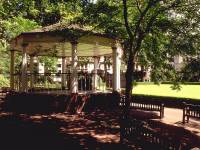 |
Finsbury Circus
August, 1995 |
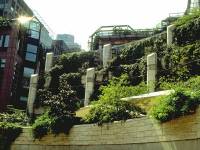 |
Liverpool Street and Broadgate
August 1995 |
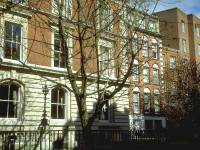 |
The Temple
February 2000 |
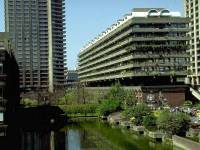 |
The Barbican
April, 2000 |
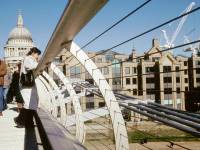 |
The Millennium Bridge
March, 2002 |
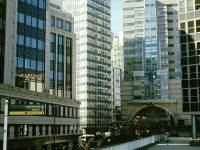 |
London Wall
March, 2002 |
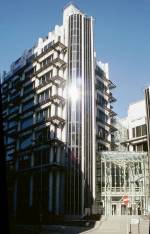 |
Moorgate
March, 2002 |
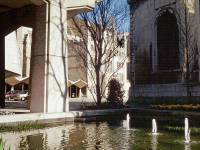 |
The Guildhall
March, 2002 |
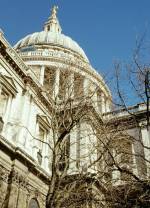 |
St Paul's Cathedral
March, 2002 |
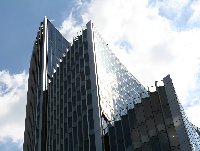 |
The
Insurance Quarter January, 2008 |
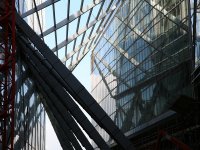 |
Bishopsgate August, 2008 |
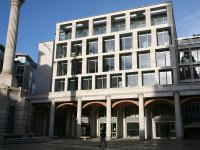 |
Paternoster
Square February, 2009 |
Back to London Cityscapes index
This page last updated 15th February 2009
![]()